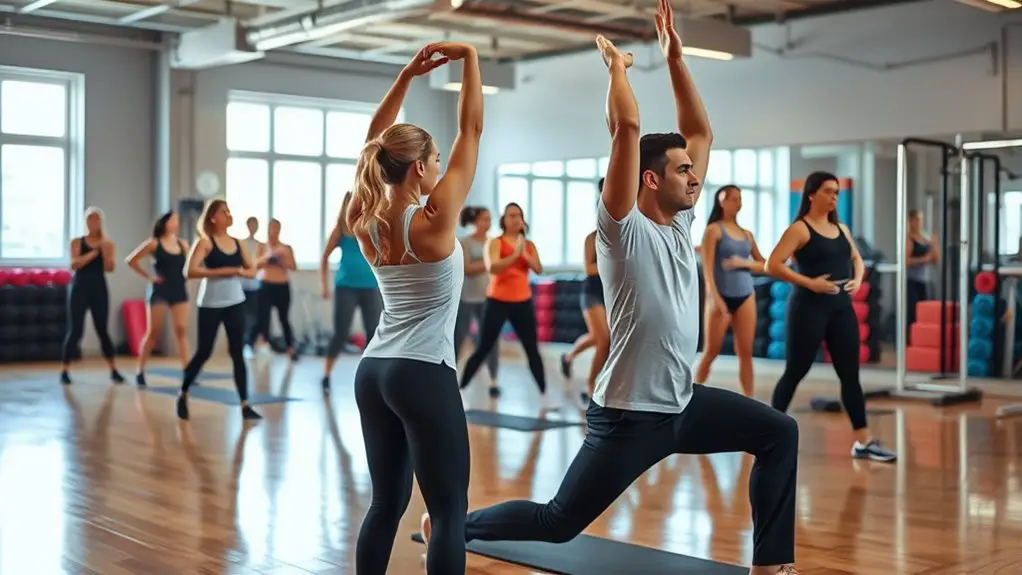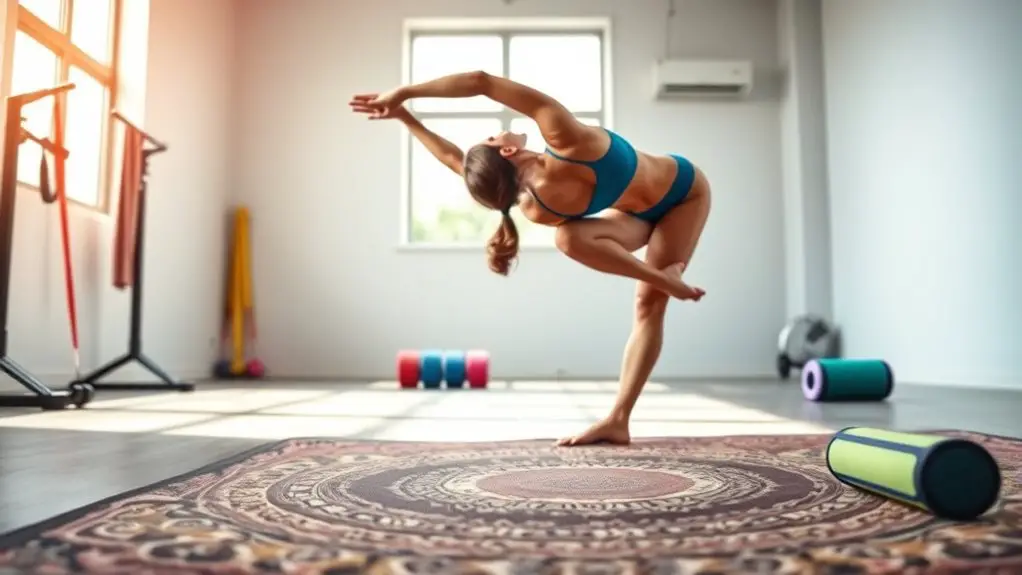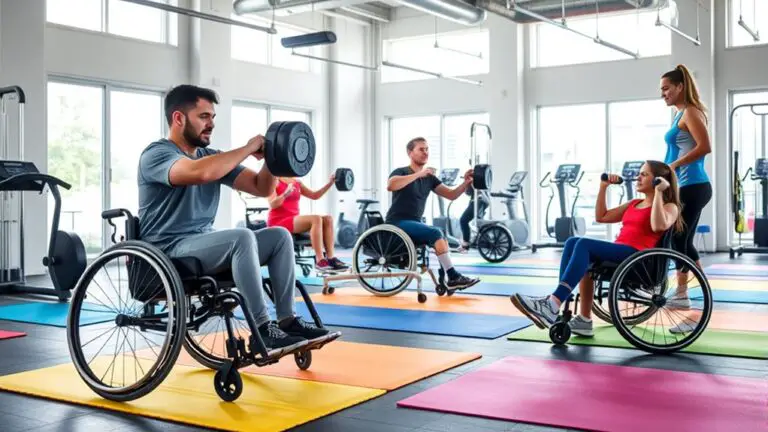How to Improve Your Posture With Gym Workouts

To improve your posture with gym workouts, focus on strengthening key muscles like your core and upper back. Start with warm-up exercises to prepare your body, followed by strengthening routines like planks and seated rows. Incorporate balance training, such as single-leg stands, to enhance stability. Aim for consistency by scheduling workouts and tracking progress. Remember to integrate posture-friendly habits daily, and you’ll notice significant improvements. There’s more to discover on how to enhance your posture effectively.
Understanding the Importance of Good Posture

Good posture isn’t just about standing tall; it’s essential for your overall health and well-being. When you maintain good posture, you can experience numerous posture benefits, such as reduced back pain, improved circulation, and enhanced mood. It’s not just about aesthetics; your body functions better when aligned properly.
Being mindful of your posture awareness throughout the day can help you avoid unnecessary strain and injury. Whether you’re sitting at your desk or lifting weights, keeping your spine aligned is vital. By focusing on how you hold your body, you can create a safer environment for yourself, improving your performance in workouts and daily activities alike.
Key Muscles Involved in Posture
To improve your posture, it’s essential to focus on strengthening your core muscles and activating your upper back. These muscle groups play a significant role in supporting your spine and maintaining proper alignment. By targeting them in your workouts, you can achieve better posture and overall stability. Additionally, incorporating exercises like skipping rope can enhance coordination and balance, further supporting your posture improvement efforts.
Core Muscles Strengthening
Strong core muscles are essential for maintaining good posture, as they provide the stability and support needed for your spine. By focusing on core strength, you’ll enhance core stability, which directly influences your pelvic alignment. When your pelvis is properly aligned, it helps distribute your body weight evenly, reducing strain on your back and promoting comfort. Incorporate exercises like planks, bridges, and abdominal crunches into your routine to strengthen these key muscles. Remember to engage your core during daily activities, too; this reinforces your posture outside the gym. Maintaining a strong core not only supports your spine but also helps prevent injuries, allowing you to move with confidence in your workouts and daily life.
Upper Back Activation
Activating your upper back muscles is essential for achieving proper posture, as they play an important role in supporting your spine and shoulders. By focusing on muscle engagement in this area, you can reduce strain and enhance stability. Here are some effective exercises to help you activate your upper back safely:
- Rows: Use resistance bands or dumbbells to pull towards your torso.
- Face Pulls: Target your rear deltoids and upper traps with a cable machine.
- Scapular Retractions: Squeeze your shoulder blades together while standing or seated.
- Pull-Ups or Assisted Pull-Ups: Engage multiple upper back muscles.
- Reverse Flys: Strengthen your upper back while maintaining proper form.
Incorporate these exercises into your routine to improve your overall posture!
Warm-Up Exercises to Prepare Your Body

Before you hit the gym, warming up is vital for preparing your body and preventing injuries. Incorporating dynamic stretching techniques and mobility drills can help activate your muscles and improve your range of motion. This sets the stage for a more effective workout focused on enhancing your posture.
Dynamic Stretching Techniques
Dynamic stretching techniques are an essential part of any warm-up routine, especially when you’re looking to improve your posture through gym workouts. These dynamic warm-ups help enhance your flexibility and prepare your muscles for exercise, reducing the risk of injury. Here are some effective dynamic stretching exercises you can incorporate into your flexibility routines:
- Arm Circles
- Leg Swings
- Walking Lunges
- High Knees
- Torso Twists
Mobility Drills Importance
Incorporating mobility drills into your warm-up routine is essential for optimizing performance and maintaining good posture during workouts. These exercises enhance joint flexibility, allowing you to move more freely and reducing the risk of injury. By focusing on mobility, you’ll experience significant mobility benefits, like improved range of motion and better overall stability. This not only helps you perform exercises correctly but also supports your body’s alignment, which is vital for maintaining good posture. When you prioritize mobility drills, you prepare your muscles and joints for the demands of your workout, ensuring you stay safe and effective. So, make these drills a regular part of your routine, and watch your posture and performance improve!
Strengthening Exercises for Better Posture
To maintain good posture, you need to focus on strengthening key muscle groups that support your spine and alignment. This isn’t just about aesthetics; it’s essential for your overall health. By incorporating specific exercises into your routine, you can achieve effective posture correction and improve muscle alignment.
Here are some safe and effective strengthening exercises to take into account:
- Planks: Engages your core, promoting stability.
- Supermans: Strengthens your back muscles, enhancing support for your spine.
- Seated Rows: Targets upper back muscles, improving posture.
- Wall Sits: Builds leg strength while reinforcing proper alignment.
- Glute Bridges: Activates your glutes and lower back, vital for support.
Additionally, incorporating regular aerobic activities such as skipping rope can further enhance your overall fitness and promote stronger posture.
Stretching Exercises to Enhance Flexibility

While strengthening exercises are essential for good posture, stretching is equally important for enhancing flexibility and maintaining a balanced body. Incorporating both static and dynamic stretches into your routine can help you achieve this.
Static stretches, like holding a hamstring stretch for 20-30 seconds, can improve your flexibility over time without risking injury. Make sure to ease into each stretch and avoid pushing yourself too hard. On the other hand, dynamic stretches, such as arm circles or leg swings, are great for warming up before your workouts and preparing your muscles for movement.
Remember to focus on major muscle groups, including your back, chest, and hips, as they play a significant role in posture. Always listen to your body; if something doesn’t feel right, stop. By incorporating these stretching exercises safely, you’ll enhance your flexibility, leading to improved posture and overall well-being.
Incorporating Balance Training
Balance training is an essential component of any workout routine, especially when it comes to improving posture. By incorporating balance exercises into your regimen, you’ll enhance your stability and reduce the risk of injury. Here are some effective balance exercises to keep in mind:
Incorporating balance exercises into your routine not only improves posture but also enhances stability and reduces injury risk.
- Single-leg stands: Hold onto a wall or chair for support and lift one leg, focusing on stability.
- Bosu ball squats: Use a Bosu ball to add instability while performing squats, engaging your core.
- Heel-to-toe walk: Walk in a straight line, placing your heel directly in front of your toe with each step.
- Balance board workouts: Use a balance board to challenge your stability and strengthen your core.
- Yoga tree pose: Stand on one leg and place the other foot on your inner thigh, focusing on maintaining balance.
Incorporating these stability training exercises can greatly enhance your overall posture and body awareness.
Creating a Consistent Workout Routine
Establishing a consistent workout routine is essential for improving your posture and overall fitness, as it helps build muscle memory and reinforces good habits. To achieve workout consistency, set aside specific days and times each week dedicated to your fitness goals. This not only helps you stay committed but also allows your body to adapt to the exercises.
Consider routine tracking to monitor your progress. You can use a journal or mobile app to record workouts, noting exercises, sets, and repetitions. This practice not only keeps you accountable but also highlights areas needing improvement.
As you progress, don’t hesitate to adjust your workouts to keep them challenging yet safe. Incorporate exercises that target your core, back, and shoulders, which are vital for maintaining proper posture. Remember, a consistent routine forms the foundation for lasting results, so stay dedicated and celebrate your achievements along the way! Tracking personal benchmarks over time is crucial for assessing your overall fitness journey.
Tips for Maintaining Good Posture Throughout the Day
After committing to a consistent workout routine, it’s important to carry that dedication into your daily life for ideal posture. By integrating a few simple habits, you can maintain good posture throughout the day, especially if you work at a desk. Here are some tips to keep in mind:
Maintaining good posture requires daily dedication and simple habits, especially for those who work at a desk.
- Adjust your desk ergonomics: Verify your chair and monitor are at the right height.
- Take breaks: Stand up and stretch every 30 minutes to relieve tension.
- Use daily reminders: Set alarms on your phone to check your posture regularly.
- Engage your core: Keep your abdominal muscles slightly tightened to support your spine.
- Practice mindful sitting: Sit back in your chair, keeping your feet flat on the ground.
Frequently Asked Questions
Can Poor Posture Lead to Long-Term Health Issues?
Yes, poor posture can definitely lead to long-term health issues. When you don’t maintain proper spinal alignment, it can cause muscle imbalances that strain your body over time. These imbalances may result in chronic pain, decreased mobility, and even affect your overall well-being. It’s important to be mindful of your posture throughout the day to prevent these potential problems. Taking steps to improve it can greatly enhance your health and comfort.
How Long Until I See Improvements in My Posture?
When you’re wondering how long it’ll take to see improvements in your posture, it really depends on your workout consistency. Typically, you might start noticing changes within four to six weeks if you’re dedicated to your routine. Remember, everyone’s body responds differently, so it’s important to listen to yours and avoid pushing too hard. With patience and regular effort, you’ll gradually see a positive shift in your posture timelines.
Are There Specific Gym Machines for Posture Improvement?
Absolutely, there are gym machines designed for posture correction! Think of the seated row or lat pulldown machines; they help strengthen your back muscles, promoting better alignment. You might worry about safety, but using these machines with proper form and lighter weights can minimize risks. Incorporating strength training into your routine not only builds muscle but also supports your spine, helping you stand tall and confident in no time.
How Often Should I Do Posture Workouts Each Week?
You should aim to do posture workouts at least two to three times a week for ideal results. Consistency is key, so try to incorporate them into your regular routine. This frequency helps strengthen the muscles that support proper posture while minimizing the risk of injury. Remember to listen to your body and adjust the intensity as needed; safety’s important, and gradual progress will lead to lasting improvements in your posture.
Can Yoga Help With Posture Improvement?
Yes, yoga can definitely help with posture improvement. It offers numerous benefits, like enhancing flexibility and strengthening your core muscles, which are essential for maintaining good alignment. You’ll learn alignment techniques that promote awareness of your body, helping you adjust your posture in daily life. Just remember to practice safely, listening to your body, and not pushing beyond your limits. With consistent practice, you’ll likely notice significant improvements in your posture over time.





